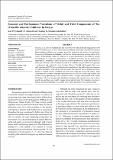Seasonal and Environment Variations of Yields and Yield Components of Tea (Camellia sinensis) Cultivars in Kenya

View/
Publication Date
2017Author
Nyabundi, Karl W
Owuor, P. Okinda
Netondo., Godfrey W.
Bore, John K
Metadata
Show full item recordAbstract/
In Kenya, tea is grown in highlands east and west of the Rift Valley at altitudes ranging from 1300 m to 2700 m above mean sea level. These areas vary widely in seasonal and locational environmental factors leading to differences in responses in growth, productivity and quality of tea genotypes. Despite these differences, tea husbandry practices are uniform across tea growing regions in the country. Understanding modes of variations in tea growth parameters and yields to varying environments is crucial for optimization of husbandry practices for tea productivity improvements. Responses in clonal tea growth and yield parameters to season and locations of production effects and their contribution to yields were evaluated, using 20 cultivars in a genotype × environment trial conducted in three locations (Kipkebe, Timbilil and Kangaita). There were yield variations (pd”0.05) between clones, locations and seasons. Tea yield components responses to weather parameters varied with location and season. Shoot growth rates in Kangaita and shoot
density in Timbilil linearly correlated (pd”0.05) with yields but varied with season. Yield
components and weather parameters contribution to the yield also varied with location and seasons causing significant (pd”0.05) interactions effects. Drought reduced yields while rainfall distribution influenced seasonal yield distribution. Seasonal yield variations were due to shoot growth rate, and shoot dry weight changes but not shoot density. The variations were due to seasonal environmental factors that limited yields rather than factors that increased yields.
Collections
- Department of Chemistry [339]
